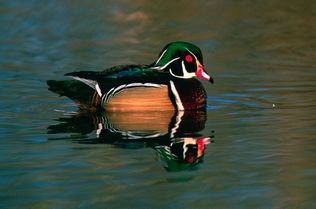
Wood ducks are among the many birds you can see at Nisqually National Wildlife Refuge.
By Sharon Wootton, The Herald
If you haven’t done any recent bird-watching in the Nisqually National Wildlife Refuge, now’s a good time. Birds of all sizes and stripes are passing through, and you can watch them from an excellent boardwalk.
One birder reported seeing a great egret, a great horned owl family and a rufous hummingbird chasing a Northern shrike. Look for wood ducks, coots, yellow-rumped warblers and wrens, and expect cliff swallows to be building nests on the refuge buildings. About 175 species of birds have been recorded here, so it’s worth a trip.
To get to the refuge, take exit 114 off I-5 between Olympia and Fort Lewis.
One physical highlight of the estuary is the Twin Barns Loop Trail, which includes a mile-long boardwalk through woods, grasslands and freshwater marshes.
There are several trails that include viewing platforms, towers and mounted viewing scopes. Several places on the boardwalk have railings that are lower than usual so that wheelchair-bound birders have better views.
For more information, go to www.fws.gov/refuge/Nisqually.
Trail to Turtleback. The Washington Trails Association is hosting a Volunteer Vacation from May 4 to 11 on Orcas Island as well as several events on May 10.
The San Juan Preservation Trust has planned a new trail to the Turtleback Mountain Preserve with stunning views that have been inaccessible. The preserve protects the entire ridgeline.
Although the weeklong vacation is full, May 10 options include working with the trail crew, hiking a 3-mile round-trip section to the turtle’s head, or meeting the volunteers for a barbecue dinner.
For more information, go to www.wta.org. While you’re there, check out the other vacations; some are already full.
Octopus protection. Hunting can occur in the water as well as on land. The giant Pacific octopus is one target for divers. Current rules allow someone with a valid state fishing license to harvest one giant Pacific octopus a day in most of Puget Sound.
The Washington Fish and Wildlife Commission has agreed to consider four options to provide more protection to that population, and those options, as well as no change and a total ban, are open to public comment.
Petitions signed by hundreds of scuba divers and others sought protection for octopuses from recreational harvest. For more information and to comment, go to www.wdfw.wa.gov/fishing/regulations/octopus, through May 31.
Mushroom Maynia. It’s that time for Seattle’s Burke Museum of Natural History’s annual fungi event. Attend talks, bring mushrooms for identification, take part in fungi crafts and learn how to cultivate edible mushrooms.
It runs from 10 a.m. to 4 p.m. May 11. The day is included with museum admission, $10 general, $8 senior, $7.50 youth. The Burke is at NE 45th St. and 17th Ave. NE.
Reserve your spot. A new reservation system for wilderness camping in Olympic National Park has started. Requests for wilderness camping areas with overnight use limits now are being accepted by postal mail or fax; no phone reservations are allowed.
Permits are required for the following high-use wilderness camp areas: Ozette Coast, Royal Basin/Lake area, Grand Valley and Badger Valley area; Lake Constance, Upper Lena Lake, Flapjack Lake, Sol Duc/Seven Basin/Mink Lake area, Hoh Lake and C.B. Flats, Elk Lake and Glacier Meadows, and group and stock camp sites along the Hoh River Trail.
